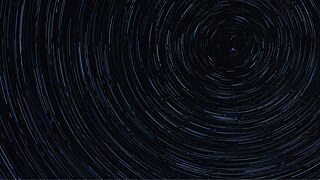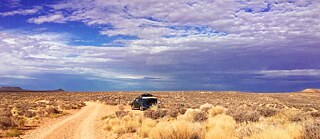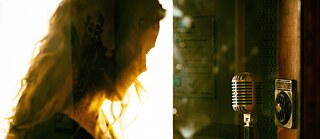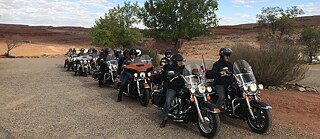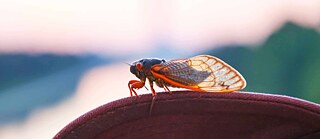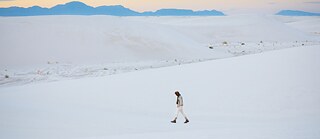Die Weiten der USA ergründen
Road Trip
Cariad Harmon und ihr Freund John Kesling machen sich zu einem lang ersehnten Roadtrip auf. Unterwegs kommt Cariad in Nationalparks, an Tankstellen und in Diners mit anderen Reisenden und mit Einheimischen ins Gespräch – eine Podcastfolge „on the road“.
Diese Folge anhören: Apple Music | Spotify | Download
Diese Folge kommt von Cariad Harmon. Cariad arbeitet als selbständige Radioproduzentin, Autorin und Musikerin in Nashville, Tennessee. Ursprünglich kommt sie aus Großbritannien, aber sie lebt nun in der ‚Music City‘, wo sie ihren Lieblingsbeschäftigungen – Musik und Podcasts machen – nachgeht. Momentan arbeitet sie am liebsten an Geschichten wie dieser, als Produzentin für die Great Feeling Studios gemeinsam mit Jakob Lewis – der auch bereits Folgen für THE BIG PONDER produziert hat. Mehr über Cariad und ihre Arbeit findet man auf ihrer Website. Die Musik in dieser Folge stammt zum größten Teil von Blue Dot Sessions, der Song „Lonely Banjo“ von Rémy Jouffroy kommt von Envato Elements. Außer ihrer „Roadtrip“-Geschichte gibt es bei THE BIG PONDER von Cariad Harmon die Folge „Record Booth“ zu hören. Und ein begleitendes Interview hat „HowSound“ veröffentlicht.
Land Acknowledgement von Cariad Harmon: „This whole story is largely about the beauty and majesty of the American landscape. All of which has a long and storied history that stretches back many thousands of years before colonization. I want to acknowledge the painful history of genocide in all of the territory we visited, which includes six of the country’s 29 states that housed Native Boarding Schools until the 1970s. Finally, I would like to honor the many diverse Indigenous peoples still connected to the land in this story and offer my deep respect and gratitude to the elders, both past and present who have stewarded this incredible landscape for countless generations. We began our story in Los Angeles, the ancestral home of the Kizh, Tongva, and Chumash. Our next stops were Virgin, Cedar Breaks, and Zion in Utah, as well as the Grand Canyon’s North Rim in Arizona, all of which are the ancestral lands of the Pueblo and Southern Paiute. We went to Horseshoe Bend in Arizona, the traditional lands of the Hopi, Navajo, Southern Paiute, Pueblo, and Ute. From there, we traveled to Mesa Verde in Southern Colorado and the ancestral lands of the Navajo, Pueblo, and Ute. We spoke with truckers in Holcomb, Kansas, the ancestral home of the Osage, Kiowa, Arapaho, Comanche, Pawnee, and Lakota. And also in Mascoutah, Illinois, the traditional land of the Kickapoo, Kaskaskia, Osage, Miami, Quapaw, and the Potawatomi. We spent our last night at Graham Caves State Park in Missouri, the ancestral home of the Kickapoo, Peoria, Kaskaskia, and Osage before coming home to Nashville, where I live on the ancestral lands of the Cherokee and Shawnee.“
Transkript
Cariad Harmon: When I was a teenager in the UK, I had no real desire to visit America. To me, the USA was shopping malls and high schools full of football players and cheerleaders. It seemed so predictable. So ordinary. But then one night, flipping through the channels on my parents’ TV, I found a movie that changed everything. [MOTORBIKE NOISE] Easy Rider. [MUSIC] Peter Fonda, Dennis Hopper and Jack Nicholson, riding across America on 2 chrome and steel Harley Davidsons. I watched miles of desert unfold in the distance, glistening blue skies and cavernous canyons. This America had nothing to do with strip malls and tanning salons. It was wild and endless. It was freedom. This was my first introduction to the Great American Road Trip.Katie Gilenna: I don’t like rules; you stop where you want to stop
Palm Springs Family: There’s a time to talk. There’s time to laugh and time to make the wrong detour.
James Ginella: It looks like it’s the land that time forgot, you know, I keep waiting for a dinosaur to poke his head out around the corner.
Cariad Harmon: 25 years after that Easy Rider awakening, and I’ve made America my home. But after all this time, I’ve still never taken a road trip of my own. I was always so busy working. Life just ... got in the way. [CAR DOOR] So last year, when news of the COVID vaccines finally arrived, it was clear. The time had come to put the pedal to the metal, except in a converted Honda Element instead of a Harley. This summer I’m finally hitting the highway with my boyfriend John. After a year of lockdowns and isolation, I want to know who else is out there on the open road. And is it everything they dreamed it would be? To find out, I’ll be talking with locals, road trippers, and a few people who make their living on the interstate. So, buckle your seatbelt and join us, as we drive 2,000 miles from Los Angeles to Nashville. [SINGING] Our first stop? The iconic Zion National Park in Southern Utah.
[SINGING AND MUSIC]
Cariad Harmon: John and I leave LA in a heatwave, but as we drive into the desert and wind our way through the sparse wilderness of Nevada, we watch storm clouds gathering on the road ahead. [IPHONE WEATHER ALERT] Huge swaths of sky turn a dark moody blue, and our phones screech with weather alerts. Much to our dismay, it’s beginning to look like we might not make it to Zion today after all. By the time we arrive at Utah’s Virgin River, the whole town is gathered on a bridge, watching a thick black cascade of water stream down from the canyons above. [DRONE SOUND] We spot two men flying drones above the crowd. So I ask them what’s going on
Cariad Harmon: So is the river usually like this, or is this more ...?
Kramer: No this is a flash flood, it’s super dangerous.
Cariad Harmon: Adam Freeman owns a tubing business, right here on the edge of the park and he says the whole state of Utah is in the middle of a historic drought.
Adam Freeman: Yeah, we’ve been open for 3 years and this is the first flash flood we’ve had and usually they get them 4 or 5 times a summer.
Cariad Harmon: Monsoon season hits the Southwest every year, but because the land is so dry here, it can’t absorb sudden heavy rainfall. Instead, the water slides and gushes through the canyons, flooding washes in minutes. Trapping hikers and tourists in steep gorges with no way out. Right now, just 10 miles to the East in Zion National Park, there’s already a search and rescue operation underway.
Kramer: That’s a road ... Completely covered.
Cariad Harmon: Adam’s friend Kramer shows us pictures of the entrance where cars have been submerged, and we thank our lucky stars we didn’t get caught up in it ourselves. It’s not quite the start we’d planned, but that’s just the way road trips go. They’re unpredictable. And you have to roll with the punches. Since Zion’s closed, Adam tells us we should meet a friend of his tomorrow up in the mountains instead. [MUSIC] And just like that, our plans have changed, and the adventure has begun.
Cariad Harmon: Can you tell me what’s special about a road trip instead of just flying somewhere and staying in a hotel?
Shahsiah Family: Because you see everything with the road trip ... You see people, the locals, the back roads.
Angelina Sheppard: I don’t think you really see the landscape change as much when you’re on a plane. There’s something really special about that.
Michelle Eisley: It just feels free to be over the road, the driving, even the traffic, it’s lovely.
James Ginella: Just doing it, just getting out and doing it!
[MUSIC FADES OUT]
Cariad Harmon: [HUM OF A CAR AND SIRI DIRECTIONS] We’re zig-zagging our way up a Utah mountain road, heading into Cedar Breaks National Monument. It’s a short drive from the desert floor, but the dry brush and rock has already given way to pine trees and wildflowers. The road switches back and climbs until finally, at ten thousand feet, we step out into a lush green forest at the crown of the Grand Staircase.
Cariad Harmon:: Oh my God. That color is insane.
Matthias Schmitt: Yes! The colors are ...
Cariad Harmon: We meet Adam’s friend, Matthias Schmitt here. He’s the Dark Sky coordinator at Cedar Breaks National Monument, one of 60 designated dark sky parks in the United States.
Cariad Harmon: Could you describe what we’re looking at?
Matthias Schmitt: We’re looking at, you know, maybe 10 miles down the canyon with different layers of limestone and sandstone that are purple, red, whitish. It literally looks like the layers of a birthday cake, and you can just take a gigantic swab and get a sugar high except that this isn’t sugar, this is a natural wonder.
Cariad Harmon: Matthias is from a small town in Southern Germany, named Singen. And like me, he moved to America in his 20s, and spent 15 years living in New York City.
Matthias Schmitt: My friends ask me what’s New York City like, and I tell them it’s like a very smoothly polished mirror, the way you feel about yourself, it reflects it back on you. So if you feel great and amazing, New York City can be a great and amazing place. And if you feel shitty about yourself, it’s the shittiest place in the world.
Cariad Harmon: At the end of 2017, Matthias was firmly in the latter camp. He was burned out, anxious, overwhelmed. So he took a few vacation days, and travelled to Oregon for the solar eclipse
Matthias Schmitt: Something happened to me and I got rejuvenated, invigorated. Of course when you see your first eclipse you’re speechless and your left brain doesn’t know what to do with the right brain because all of a sudden where the sun was a moment ago there’s a black hole.
Cariad Harmon: And then last year, he started looking for jobs away from New York City. Somewhere he could see the sky. And a few months later. He took a one-way road trip of his own.
Matthias Schmitt: I left New York on a Sunday afternoon at 3 o’clock after the movers did their job and I drove across the country in six days. [MUSIC] The first night I came up to the park to look at the night sky and I went wow! The Milky Way! I can’t see the constellations, there are so many stars.
Cariad Harmon: Oh my god ... whoa! You definitely made a good call.
Matthias Schmitt: I made a very good call. Yes.
Cariad Harmon: Standing here, looking out across the canyon with Matthias and John, I think about all the jobs I’ve had that kept me too busy for trips like this one. The gigs, the waitressing, the bartending. Chasing a dream that was always right around the corner. For the first time in a long time, the only place I want to be is exactly where I am.
[MUSIC]
Cariad Harmon: How does it make you feel looking at landscape like this?
Angel Stallings: At peace. Disconnected from technology and just the regular grind and connected to nature. And God’s beautiful creation. Like I just want to take it all in.
Mikki Baloy: This is so primordial and ancient, and it’ll be here long after we’re gone. It’s, it’s epic for us, but we are nothing. We are nothing to this.
Ashley Green: Back home, we don’t usually see all this. it’s full of buildings and houses and homes, but out here, it’s just, sky and mountains and land and sunlight.
Millod Shahsiah: It’s just so magnificent and beautiful that every turn, you’re like, Wow. You want to stop but like ... we’ve got to get to the next point!
Cariad Harmon: John and I have to get to the next point too. 150 miles from the top of the Grand Staircase, all the way to Arizona and the very bottom step.
Cariad Harmon: So, tell me where we are right now.
John Kesling: Well, I’m sitting on a rock on the north rim of the Grand Canyon, and we’re way too close to the edge
[MUSIC]
Cariad Harmon: And what does it look like?
John Kesling: It’s really hard to describe it. Every couple of seconds, the light changes so dramatically, something that was bright and vivid, in an instant, a cloud will go over and then it becomes completely in shadow and changes color and tone. Look at that ... that Hawk, what is that?
Cariad Harmon: [BIRDSONG] oh there’s a bird right underneath us and another one! Ohh oh my gosh!
John Kesling: Yeah they’re iridescent, it’s so beautiful! [GIGGLES]
[NIGHTTIME AMBIENT SOUND]
Cariad Harmon: Tonight, at a campsite just a few feet from the edge of the Canyon, John and I eat our dinner in the dark and stare up at the sky.
Cariad Harmon: Do you see the Milky Way?
John Kesling: Wait, that’s what I’m seeing?
Cariad Harmon: Yeah it’s not clouds it’s the Milky Way.
Cariad Harmon: We find the Big Dipper, and the North Star. We imagine the earth rotating on its axis. And we tell each other how lucky we are to be here, together, in the back of our little Honda.
[MUSIC]
Cariad Harmon: As a family, do you think road trips bring you closer?
Shahsiah family: Yes, we sing. We laugh. We talk about everything. Yeah. We forgot about all the problems back home.
Angelina Sheppard: It really gives time to talk and just catch up because, I mean, he works two jobs and I work six days a week.
Mikki Baloy: There’s something about being in the car that kind of creates a different level of conversation, and it’s quality time even if we’re not doing anything.
Raghu Thirumala: But you can imagine what it is like, you know, for 12 people to sit in a 12-seat passenger and drive all the way from California, but we are, we are having fun.
Dina Inderlee: Of course we’re going to fight. There are three people in a car. You fight, you get over it, and then you move on.
[MUSIC FADES OUT]
Cariad Harmon: Back on the road, I spot an interesting looking couple. They’re standing next to a huge RV, and one of them has a beautifully groomed white ZZ-top style beard. So we stop and ask them how their road trip’s going.
Joy Burle: We’re loving it. We are absolutely loving it. This is our dream.
Cariad Harmon: Joy and Roger Burle are from a small Georgia town named Bogart, and they’re both 62 years old.
Roger Burle: We had planned all of our lives. Trying to manage money and finances and dreams and goals to where we could do a trip, a lifetime, a retirement like this.
Cariad Harmon: After 40 years of working in sales Roger retired early, just a year ago, and the pair bought a class C Sprinter Mercedes RV.
Cariad Harmon: I have to say it suits you. You’re both just beaming.
Joy Burle: Oh, it has not disappointed us. You know, a lot of times you have this dream and then once you get started, you’re kind of like, well, this isn’t really what I expected. This has been everything we could have expected and more.
Cariad Harmon: They’ve been on the road for 11 weeks so far, and they’re still going strong.
Roger Burle: Well, we have a wedding that we have to go to on the Saturday before Thanksgiving. So we have to be home by then.
Cariad Harmon: [LAUGHTER] Uh, and right now we’re in the beginning of July ...
Roger Burle: Yes, we have a long way to go ...
Cariad Harmon: I have to admit, I’m a little bit jealous of Roger and Joy and their retirement adventure. I mean who wouldn’t want to spend their 60s together, seeing the country and reveling in the freedom of the open road? [SOUND OF KETTLE BOILING] But the thing is, John and I aren’t traveling in a Mercedes RV. We’re packed into the back of a Honda Element and while we do love the adventure ... Moving into day 7 of our trip, let’s just say we’re a little more ... intimate than we were when we started.
Cariad Harmon: How long has it been since we’ve had a shower?
John Kesling: I think just two days …
Cariad Harmon: This being day two, or this being day 3?
John Kesling: Umm I think this is day 3.
Cariad Harmon: The thing about a road trip that they don’t really talk about on hashtag vanlife instagram is, there’s not a lot of privacy. And it can be hard to keep the romance alive.
Cariad Harmon: Can you look the other way while I just freshen up?
John Kesling: Yeah, I need to do that too ...
Cariad Harmon: For four days straight we were staying at some pretty rustic campsites so the closest thing either of us came to a shower was a packet of baby wipes in the back of the car ...
Cariad Harmon: [SINGING] Stinking up the Honda Element ...
Cariad Harmon: [SNORING SOUND] We spent the 4th of July in a Walmart Parking lot, and between our neighbors letting off fireworks and John’s snoring, I didn’t get a ton of sleep. And there isn’t always a bathroom either. So you spend an awful lot of time talking about how and when you’re going to find one ...
John Kesling: Yeah I think we’ve gotta go far away ...
Cariad Harmon: ... or where you’re going to make one of your own.
John Kesling: And then we can just find a couple of spots you know?
Cariad Harmon: [LAUGHING]
Cariad Harmon: I won’t tell you whose fart that was.
Cariad Harmon: I’m so sorry!
Cariad Harmon: But I think we can all agree that road-trip food isn’t always the easiest to digest.
Cariad Harmon: Oh no!
Cariad Harmon: What I’m saying is that it can get tough on the road. Especially if you’re on a budget. And if you need a break from one another, there’s nowhere to go. Plus, and please don’t take this personally, I just don’t think John was always thrilled about having a microphone and an audience.
Cariad Harmon: Sigh ... I think at this point we’re both pretty ... a little bit road weary, would you say that’s accurate?
John Kesling: Let’s keep going.
[MUSIC]
Cariad Harmon: What’s the most difficult thing about a road trip compared to flying or something like that?
Benjamin Backus: These aren’t very relaxing to drive. Yesterday we got lost on the Indian Reservation and the roads started to like, get worse and worse and worse.
Andrew Medina: We got stuck in some really bad weather, probably the worst weather I’ve ever ridden in, and I could barely see ...
Joey Lee: We had an accident on the way up, a deer hit our vehicle. So it’s been kind of an adventure we didn’t plan on going on.
Melanie Hernandez: It looks fun and people think it’s fun all the time, but ... it can be rough.
[MUSIC FADES OUT]
John Kesling & Cariad Harmon: [SINGING] Alabama, Alaska, Arizona, Arkansas ...
Cariad Harmon: We’re driving through the Kaibab National Forest in Arizona. 1.6 million sprawling acres of wilderness.
[MUSIC]
John Kesling: What’s this over here?
Cariad Harmon: It looks like it’s been burned to me…
Cariad Harmon: On either side of the road, the forest thins, and we see a few charred patches of brown and black. And then suddenly, we round a corner.
John Kesling: Look at that, it’s like the whole valley.
Cariad Harmon: The entire hillside is nothing but scorched earth and charred tree limbs. It goes on and on, all the way to the horizon.
Cariad Harmon: It’s hard to comprehend how big this is ... Oh my god that whole hill ... ugh!
Cariad Harmon: We don’t know it yet, but we are driving through the remains of the largest fire in the history of Kaibab National Forest. The Mangum fire began just one year ago, and raged for an entire month, destroying over 70,000 acres of Piñon Juniper and Ponderosa Pine. At its peak, the blaze was so huge, you could see the smoke from space.
Cariad Harmon: I keep thinking it’s over and then we come around a corner and then it’s just more black.
Cariad Harmon: I’ve seen forest fires on the news, but it’s not something we deal with where we live. And it’s a different experience to see the scale of it first-hand. I turn off my recorder and John and I drive for a while in silence. We don’t feel much like singing any more.
❡
Cariad Harmon: By the time we get to Colorado we’re starting to feel a little bit better. The heat of summer in the desert has broken in the mountains, and we both managed to get a good night’s sleep. We’re just outside Mesa Verde National Park, when we spot a man near the entrance painting in the shade. So we pull over to investigate and meet Herbert Wilson and his wife Darlene.
Herbert Wilson: We’re just selling different kinds of jewelry and some paintings that I do just to kill time and people buy it from me ...
Cariad Harmon: John’s a painter too, so he and Herbert talk shop for a while
Herbert Wilson: It’s oil paint
John Kesling: Oil?
Herbert Wilson: Yeah ...
Cariad Harmon: Herbert tells us he and Darlene grew up here, and they were childhood sweethearts. But he went away to a Boarding School almost 2,000 miles away in South Carolina. He was gone all of Junior and Senior year, and as soon as he was done, he couldn’t wait to get back home.
Herbert Wilson: I just wanna come back to my family and I miss all my goats and sheep. I was raised herding sheep.
Cariad Harmon: And he did miss Darlene too!
Herbert Wilson: She was my girlfriend then!
Cariad Harmon: How long have you been married?
Darlene Wilson: 50 years. We’re old goats.
John Kesling: Well he loves goats.
[ALL LAUGHING]
[MUSIC]
Cariad Harmon: From Herbert and Darlene, to Adam, Matthias, Joy, Roger and all of the folks we’ve spoken to at parks, diners and gas stations. It’s been so wonderful to connect with other people again. After this year of isolation and never-ending terrible news, the world can feel like a scary place. And it’s true. It can be frightening. And things have not been easy for a lot of people: Including John and I. But out here on the road, we’re becoming to feel a little lighter.
John Kesling: [SINGING] I can show you the world ...
Cariad Harmon: Ten days into our trip, the wilderness of the West is behind us, and we have made it to the heartland. Fields of wheat and grain stretch out in every direction and the road is one straight line from here all the way to the horizon. At this point, we are ready to start covering some miles. We miss our dog, and we could both use a meal that hasn’t been soaked in water from the cooler. So when we pull into a gas station and truck stop in Kansas, I have an idea. If I really want to know about road trip endurance, I should probably ask a professional. So, I head out past the pumps to the back lot where a row of enormous semi-trucks are idling ...
Cariad Harmon: Hi there….
Cariad Harmon: ... and see if I can flag down a few folks who might answer a question or two.
Trucker: Would you like to come up?
Cariad Harmon: Yeah I’d love to come up
Cariad Harmon: I grab onto the handles and clamber on in.
Cariad Harmon: Oh my gosh. I’ve never been inside a truck before.
Cariad Harmon: James Rowell shows me around the cabin, and it’s surprisingly roomy back there.
James Rowell: So, we’ve got an area for my snacks like popcorn, rice crispy treats ...
Cariad Harmon: There’s a double bunk, a good sized fridge, cabinets and a microwave
James Rowell: You got to remember this is a 24/7, 365 day job. Even when you’re at home, your mind is still on the road. So it’s a lifestyle. You gotta be a hundred percent committed to that lifestyle.
Cariad Harmon: James spent over 20 years in the military. Then, he worked for the government for a while, but he just couldn’t settle in an office job. So last year he went to CDL school to get his trucking license. And now ...
James Rowell: I make the decisions in running this truck, where I run, how I run, when I run, those are all on me. So that’s probably the best feeling in the world
Cariad Harmon: But, you don’t make money when you’re standing still.
James Rowell: when I go home, yeah it’s, honey, do this, honey do that. And after a while, it’s like, I just got to get back on the road. Cause I gotta make money. Cause I can’t afford all this stuff that the honey wants.
Cariad Harmon: I can totally relate to what James is saying. Even though it can be tough, I love being the captain of my own ship. I love not knowing exactly what’s going to happen tomorrow, or where I’ll be in the morning.
[MUSIC]
Cariad Harmon: But it’s hard when road-tripping is your job. And I can’t sit around talking to James all day. I’ve got a story to make.
Gene Sharpton: I’ve been driving trucks for about 38 years.
Cariad Harmon: So what keeps you doing it, why haven’t you given it up yet?
Gene Sharpton: It gets in your blood, it’s diesel running through your veins ...
Cariad Harmon: And can you tell me, how do you pass the time when you’re driving a truck for hours and hours?
Gene Sharpton: Uh, I talk with the Lord. I listen to my music ...
Michelle Eisley: Okay. I’m a little weird, but I love to listen to music that’s been on movies. Like Rock and Fast & Furious.
Cariad Harmon: Do you feel like you’re in your own little movie?
Michelle Eisley: Pretty much. Yeah. Just puts me in the groove of everything.
Cariad Harmon: In the movies, truck drivers have, like a name on the CB radio? Is that a real thing or is that just imaginary?
Keith Horney: Oh, you know, guys, that truck together’ll have a call sign or a different name.
Cariad Harmon: Do you have a call sign?
Keith Horney: Uh, yeah, I go by ‘Sunshine.‘ I always tell the guys hey, the sun’s shining, and everybody’s happy.
Cariad Harmon: Do you ever get lonely on the road?
Cliff Mauldin: Sometimes, I call my son.
Cariad Harmon: Is he going to be a trucker?
Cliff Mauldin: No! I told him, I’d kick his butt.
Cariad Harmon: How come?
Cliff Mauldin: It’s not good for family life. You’re always gone. So I missed a lot of him growing up, so I can’t get, I can’t get that back, but he understands.
[MUSIC FADES OUT]
John Kesling & Cariad Harmon: [SINGING]
Cariad Harmon: We are at Graham Caves State Park in Missouri, packing up the car at our final campsite of the trip. And we are very excited. We have just 6 hours left on the road and neither of us can wait to get home to Nashville.
Even though we are both dirty and dog tired, we have already been talking about taking another road trip in the Spring. There’s just so much more of the country to see. Of course there are a few things we’ll do differently next time. I’ll plan a little bit more in advance, make sure we have at least some idea where we’re sleeping before we leave. And we won’t travel at the height of summer again either.
But there’s something else too. After almost 20 years of living in the US, I’ve realized that road trips aren’t the only tradition I’ve embraced. I seem to have picked up a very American obsession with work as well. I mean, it took me over a decade to tear myself away for long enough to take this trip in the first place. And even then, I managed to bring my job with me, and make a story about it. Now don’t get me wrong, it’s been great having you along for the ride. But next time, I will not be bringing a microphone with me.
John Kesling: Hello. Got a hot mic. Hot mic.
Cariad Harmon: John seems to be quite enjoying having a go though ...
John Kesling: We are now back in Nashville, Tennessee USA.
Cariad Harmon: What are we doing?
John Kesling: We are three minutes away from pulling in to retrieve our dog ...
Cariad Harmon: 2000 miles, 3 packets of baby wipes and 14 bags of ice after leaving LA, we are finally home.
Cariad Harmon: Where’s that doggie?
[MUSIC]
Cariad Harmon: And now, if you don’t mind ... I’m gonna switch off the tape recorder and say hello to my dog. But hey!, if you’re feeling adventurous, maybe we’ll catch you out there on the road this spring.
[SOUNDS OF MEETING THE DOG]
Cariad Harmon: Before I sign off for real, I want to take a moment to say something important. This whole story is largely about the beauty and majesty of the American landscape. All of which has a long and storied history that stretches back many thousands of years before colonization. I want to acknowledge the painful history of genocide in all of the territory we visited, which includes 6 of the country’s 29 states that housed Native Boarding Schools until the 1970s. Finally, I would like to honor the many diverse Indigenous peoples still connected to the land in this story and offer my deep respect and gratitude to the elders, both past and present who have stewarded this incredible landscape for countless generations.
We began our story in Los Angeles, the ancestral home of the Kizh, Tongva and Chumash. Our next stops were Virgin, Cedar Breaks and Zion, in Utah, as well as the Grand Canyon’s North Rim in Arizona, all of which are the ancestral lands of the Pueblo and Southern Paiute. We went to Horseshoe Bend in Arizona, the traditional lands of the Hopi, Navajo, Southern Paiute, Pueblo and Ute. From there we travelled to Mesa Verde in Southern Colorado, and the ancestral lands of the Navajo, Pueblo and Ute. We spoke with truckers in Holcomb, Kansas, the ancestral home of the Osage, Kiowa, Arapaho, Comanche, Pawnee and Lakota. And also in Mascoutah, Illinois, the traditional land of the Kickapoo, Kaskaskia, Osage, Miami, Quapaw and the Potawatomi. We spent our last night at Graham Caves State Park in Missouri, the ancestral home of the Kickapoo, Peoria, Kaskaskia, and Osage. Before coming home to Nashville where I live on the ancestral lands of the Cherokee and Shawnee.
This story was produced by me, Cariad Harmon, and edited by Rachel Aronoff. With thanks to our consultant, Albert Bender.

